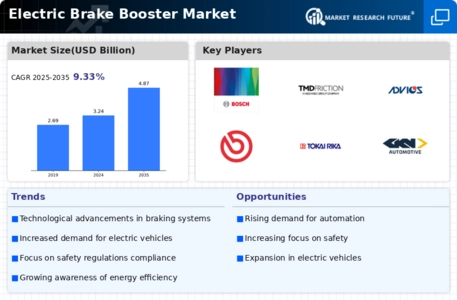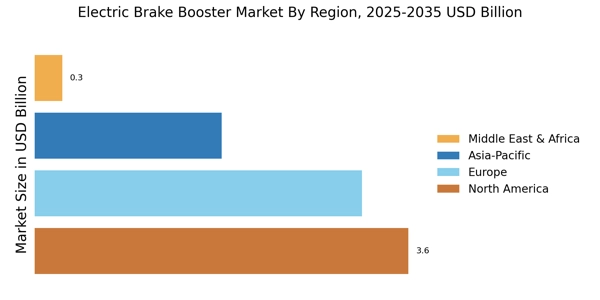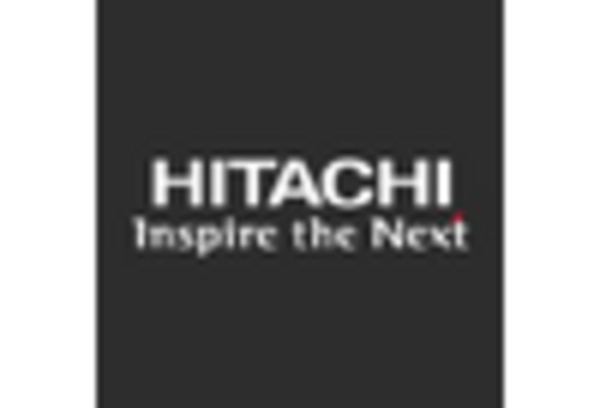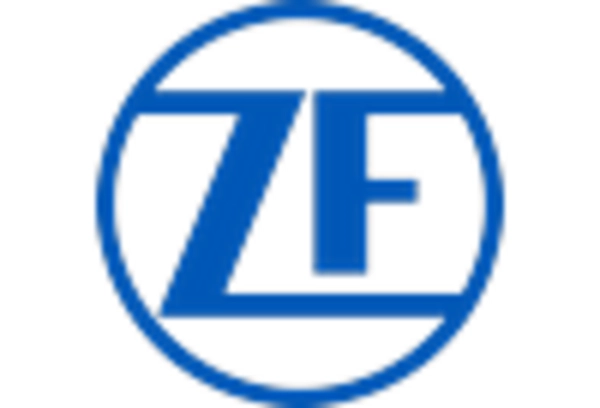Technological Innovations in Brake Systems
Technological advancements are playing a pivotal role in shaping the Electric Brake Booster Market. Innovations such as advanced sensors, artificial intelligence, and machine learning are being integrated into braking systems, enhancing their functionality and reliability. These technologies enable real-time monitoring and adjustment of braking force, improving overall vehicle performance. Furthermore, the introduction of smart braking systems that communicate with other vehicle components is expected to drive the adoption of electric brake boosters. Market analysis indicates that the integration of these technologies could lead to a reduction in braking distances by up to 30%. As manufacturers continue to invest in research and development, the Electric Brake Booster Market is likely to witness a wave of new products that leverage these technological advancements, ultimately enhancing vehicle safety and performance.
Increasing Demand for Enhanced Vehicle Safety
The Electric Brake Booster Market is experiencing a notable surge in demand driven by the increasing emphasis on vehicle safety. Consumers and manufacturers alike are prioritizing advanced braking systems that enhance vehicle control and reduce stopping distances. This trend is further supported by data indicating that vehicles equipped with electric brake boosters demonstrate improved performance in emergency braking scenarios. As safety regulations become more stringent, the adoption of electric brake boosters is likely to rise, as they offer superior responsiveness compared to traditional hydraulic systems. The integration of these systems not only meets regulatory requirements but also aligns with consumer expectations for safer driving experiences. Consequently, the Electric Brake Booster Market is poised for growth as manufacturers innovate to meet these evolving safety standards.
Shift Towards Electrification in Automotive Sector
The Electric Brake Booster Market is significantly influenced by the broader shift towards electrification within the automotive sector. As manufacturers transition from internal combustion engines to electric and hybrid vehicles, the demand for electric brake boosters is expected to increase. These systems are particularly well-suited for electric vehicles, as they provide efficient braking performance while minimizing energy consumption. Market data suggests that the electric vehicle segment is projected to grow at a compound annual growth rate of over 20% in the coming years. This transition not only enhances the performance of electric vehicles but also aligns with sustainability goals, making electric brake boosters a critical component in the evolving automotive landscape. The Electric Brake Booster Market is thus likely to benefit from this electrification trend, as manufacturers seek to optimize vehicle efficiency and performance.
Government Regulations and Incentives for Electric Vehicles
Government regulations and incentives are significantly impacting the Electric Brake Booster Market. Many countries are implementing policies aimed at promoting electric vehicle adoption, including tax incentives, rebates, and stricter emissions regulations. These initiatives encourage manufacturers to invest in electric brake booster technology, as it is essential for the performance of electric and hybrid vehicles. Market data suggests that regions with robust government support for electric vehicles are witnessing accelerated growth in the adoption of advanced braking systems. As these regulations become more prevalent, the demand for electric brake boosters is likely to increase, as they are integral to meeting compliance standards. The Electric Brake Booster Market is thus expected to benefit from these supportive governmental measures, fostering innovation and growth in the sector.
Rising Environmental Concerns and Sustainability Initiatives
The Electric Brake Booster Market is increasingly influenced by rising environmental concerns and sustainability initiatives. As consumers become more environmentally conscious, there is a growing demand for vehicles that minimize their carbon footprint. Electric brake boosters contribute to this goal by improving energy efficiency and reducing emissions associated with traditional braking systems. Additionally, regulatory bodies are implementing stricter emissions standards, prompting manufacturers to adopt more sustainable technologies. Market data indicates that the demand for eco-friendly automotive solutions is expected to grow, with electric vehicles leading the charge. This shift towards sustainability is likely to drive the adoption of electric brake boosters, as they align with the industry's efforts to create greener transportation solutions. Consequently, the Electric Brake Booster Market is positioned to thrive in this environmentally aware landscape.


















Leave a Comment